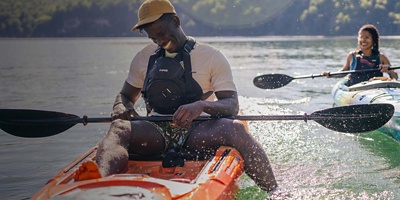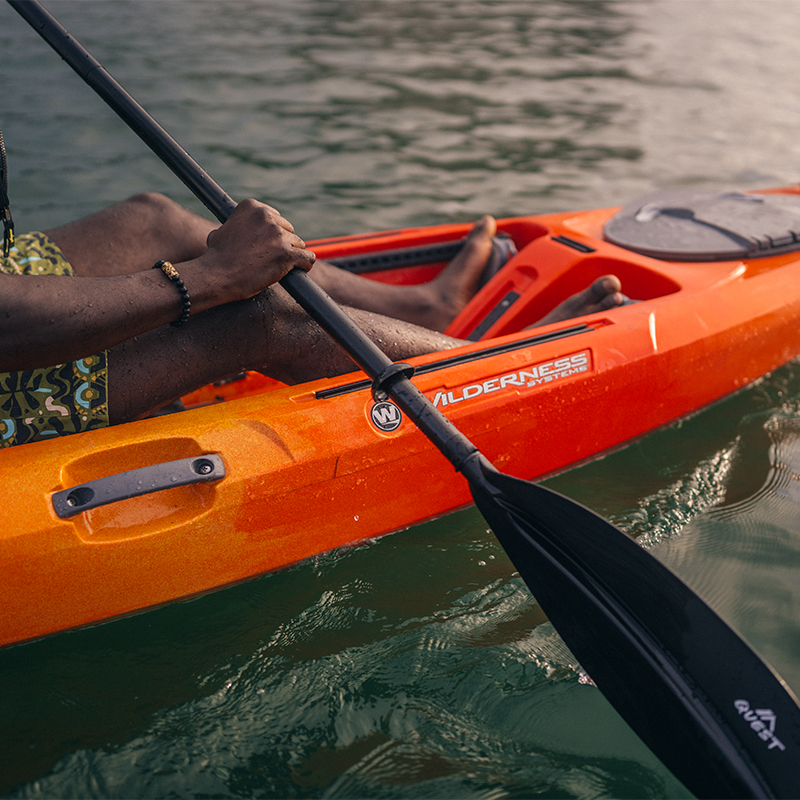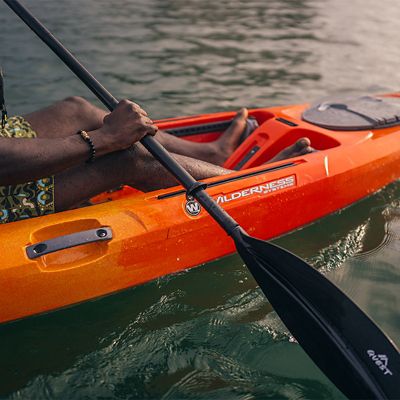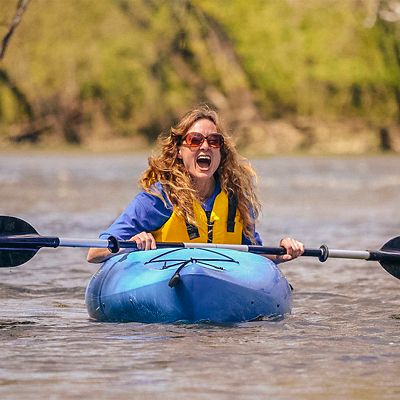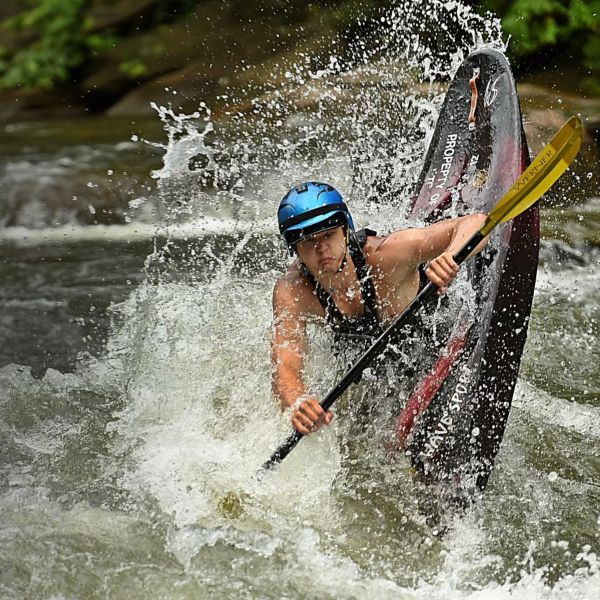Choose Your Shaft
There are a few shaft materials available with various costs and benefits.
Plastic
You’ll rarely find plastic kayak shafts paired with plastic blades. If you do, they aren’t apt to last long.
Aluminum
This is a more popular material on the entry level as a strong, inexpensive, and relatively lightweight option. What you lose in performance you gain in a paddle that can take a beating over seasons of heavy use. Aluminum is also sensitive to temperature changes (it can become hot to handle in the sun, and cold to bare hands in the winter).
Wood
Though aesthetically pleasing, and easy on the hands in colder water, wood paddles typically weigh slightly more than similarly priced composite options, and, depending on the type of wood used, offer solid durability and some forgiving flex. Though usually laminated in a fiberglass layer, wooden paddles do require some maintenance and upkeep.
Fiberglass
Fiberglass paddles are both strong, light, and more affordable than other composite shaft materials. They are less sensitive to temperature changes and will cause less fatigue over the course of a long trip. However, they are less durable than aluminum paddle shafts.
Carbon FIber
Carbon fiber paddle shafts are incredibly strong and light, though come with a heftier price tag accordingly. Not necessarily the best option for a beginner who could be subjecting the paddle to more abuse (or losing it while learning), carbon paddles certainly pay off for kayakers logging long hours where the strength and weight will have you paddling farther without fatigue.
Shaft Design
Shafts often come in different size diameters. Children and smaller adults should try the feel of a smaller-diameter option, if available. Most paddles are also available in two shaft styles: the more typical straight shaft, or the more specialized bent shaft.
Straight shafts run straight between either blade while bent shafts have two kinks that align your wrists in a more ergonomic position—a nice perk for paddlers with wrist pain or sensitivity. Both paddle shafts perform well, though your best choice will come down to comfort, preference and price, as bent shafts are usually more expensive and fix your grip in one position.
With both of these styles, it is possible to find paddle shafts that separate into multiple pieces. Most will break into two pieces for easier on-board rigging, transport and storage. If you have extremely cramped storage, are buying a spare paddle, or want the easiest paddle to carry as possible, some paddles break down into three and even four pieces. Having more joints does create more opportunity for weaknesses and failures, though, so if you don't need a four-piece paddle, stick with two pieces.
Feathered or Straight
Most paddles will allow you to adjust your blades between either feathered or straight.
A straight paddle has the blades matching, aligned along the same plane. A feathered paddle has the blades offset at different angles on either end of the shaft. Looking down the paddle, that could have one blade lined up from noon to 6 o’clock; the other lined up from 2 to 8 o’clock.
That angle difference reduces wind resistance on the blade that is moving forward, cutting through the air while the other is pulling back on water. Most paddles will give you the option between both settings (feathered or straight), some with multiple options of what degree that you prefer to set the feather angle of one blade relative to the other.
Blade Material
Plastic
Molded high-density plastic paddle blades, often made with nylon, are a popular choice because they are affordable. They are reasonably durable and will bend—helpful if you bang them into a rock, but at the cost of power lost in flexibility with more aggressive strokes. They are also susceptible to UV damage.
Wood
Wooden paddle blades offer beauty, plus the benefit of natural buoyancy and flex, which helps reduce strain over long days. Wood is also naturally durable, able to withstand impacts, and relatively simple to repair. There’s a wider range of pricing as well, depending on the wood type and degree of intricacy in layering. Wooden blades are often laminated or capped in fiberglass or other composite materials for added protection.
Composite
Fiberglass is the most typical resinated fabric layer used to reinforce other base materials, and more expensive than plastic, but this “composite” of materials is also lighter while maintaining durability. Blades are unlikely to crack, but are liable to chip if hit against rocks. While a lighter blade will make your paddling more efficient, the rigidity of a composite paddle provides more efficient strokes. Carbon fiber is the lightest and stiffest composite material used in paddle blades. But that performance comes at a high cost, best for those who are already enthusiastic paddlers ready to benefit from increased efficiency.
Blade Design
Width
Wider paddles are great for quickly making strong, high-angle strokes needed for acceleration or angle correction experienced in demanding disciplines like whitewater or surf kayaking. Constantly loading a blade with power will quickly fatigue endurance or recreational paddling efforts.
Narrower paddle blades don’t provide the same acceleration, but will allow you to paddle longer without tiring as fast. Like biking in a lower gear, narrow paddle blades are a great choice for recreational touring paddlers, or anyone who plans on taking long trips.
Symmetry
Paddle blades either come symmetrical or asymmetrical. Hold a symmetrical paddle either way and it will perform the same—ideal for beginners needing one less thing to think about when first starting to paddle.
Asymmetrical blades are the paddle norm that offer more efficient and consistent kayaking strokes. An asymmetrical blade has a longer top and a shorter bottom. Line up the longer top with your knuckles to make sure you’re holding it correctly; you’ll quickly benefit from better strokes as you move beyond recreational kayaking basics.
Dihedral or Spoon
With the “power face” of the blade now facing you, there’s a couple main blade styles to look for. A dihedral profile has a central rib running the length of the blade to help water flow off the paddle evenly. This reduces flutter and creates a more regular stroke.
A spoon profile has a slight concave curve and lacks the dihedral ridge running down its center. This allows for more efficient paddling—with proper technique. If you’re new to paddling, or need to improve your paddling technique, this scooped style can cause your paddle to flutter and make strokes less efficient.
Specialized Paddles
Some kayak paddles are built for specific purposes, most notably kayak fishing paddles. These often have a hooked notch cut into the blade that allows them to reach out and grab a fishing line should it get snagged. This only nominally affects your paddling but becomes a useful tool.

